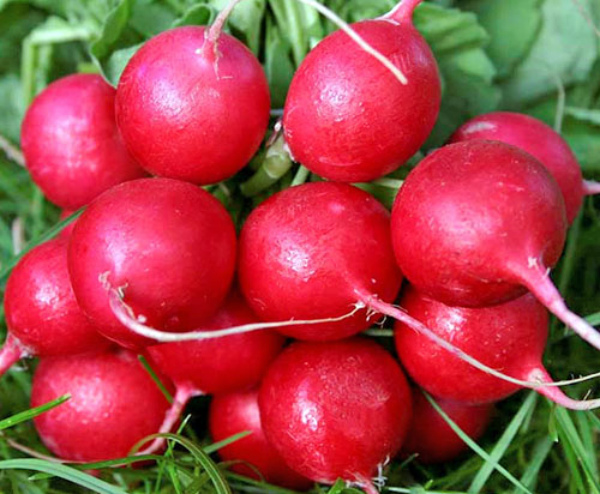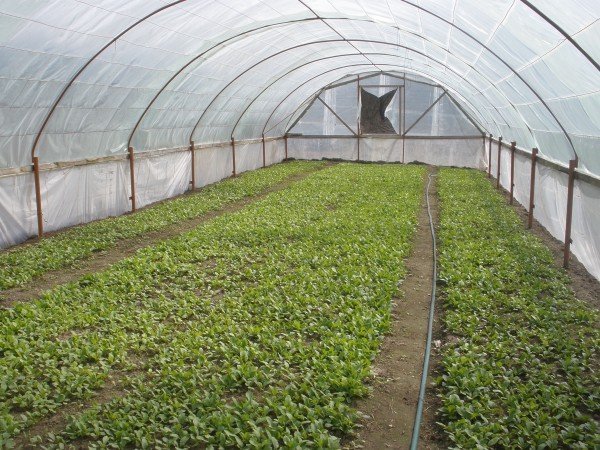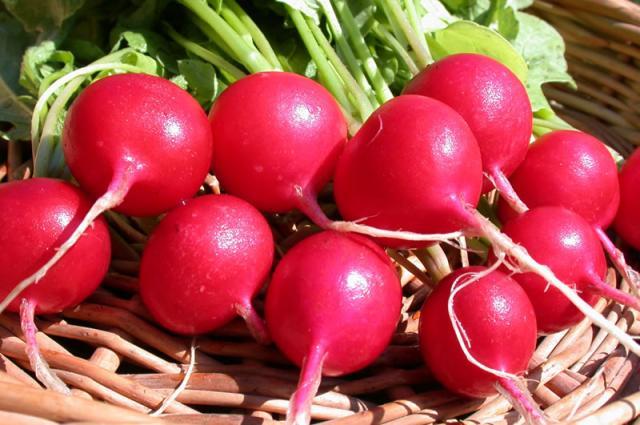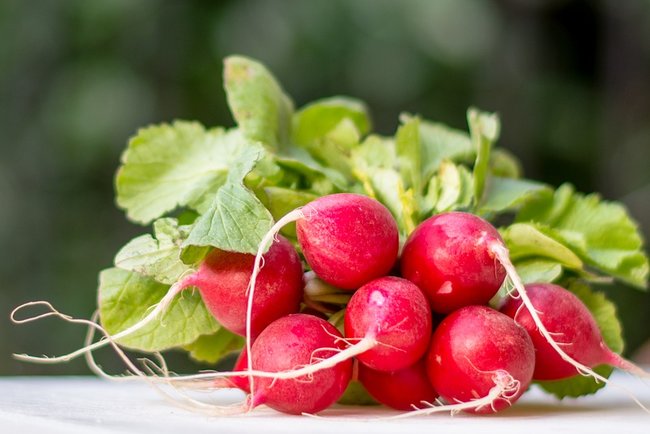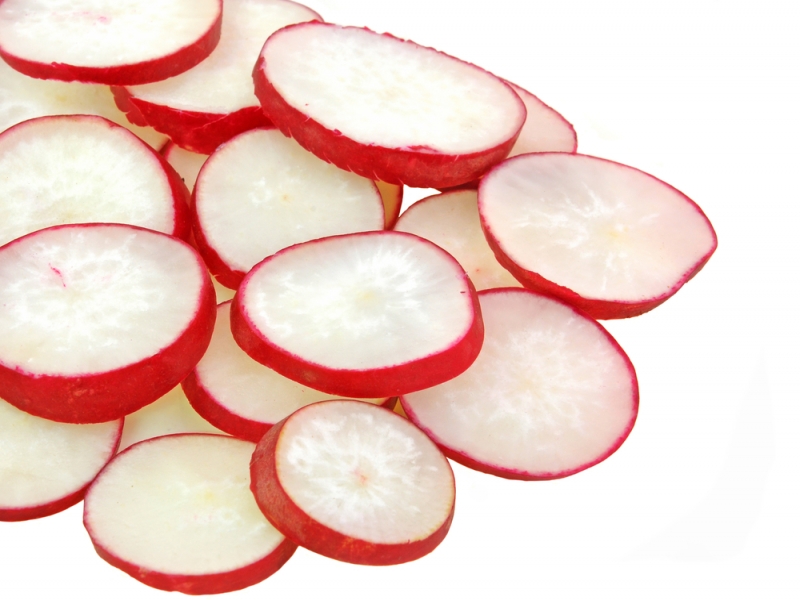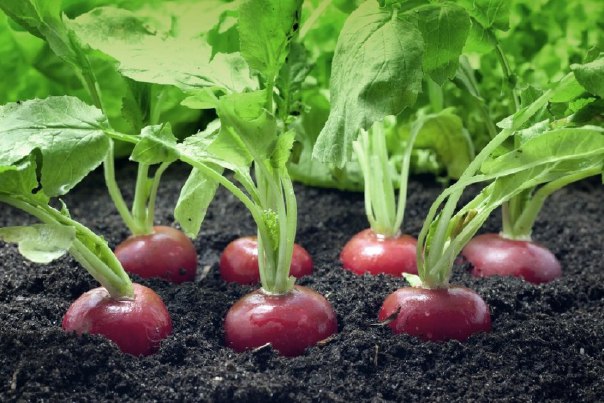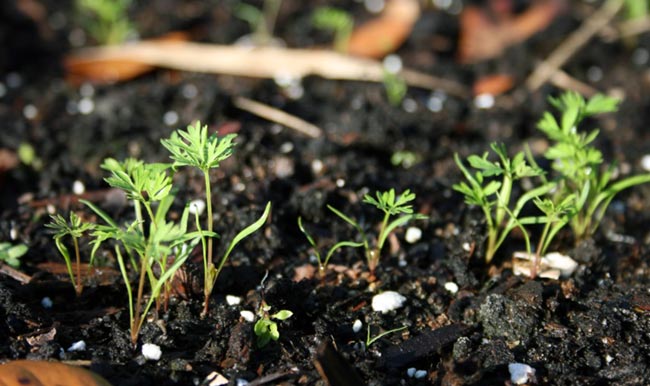Content:
Cherryat radish is suitable for cultivation at any time of the year. Having excellent taste and market characteristics, this type of radish is popular with gardeners and consumers. Almost every vegetable grower is engaged in sowing Cherriet radish, as it is also a very early variety. If you follow all the recommendations for growing, you can get a good harvest of delicious root crops.
The history of the creation of the variety
Radish Cherriet is a hybrid, bred by Dutch breeders not so long ago. It is included in the State Register as a vegetable that is recommended for cultivation in private farms.
Description of varietal characteristics
- Ø Early variety - you can get the harvest in 20-25 days;
- Ø The pulp is juicy, medium-sharp;
- Ø Leaf socket is compact;
- Ø The mature plant has firm, short tops;
- Ø Red root vegetable, has a rounded shape;
- Ø Fruit weight - about 30 g;
- Ø Productivity - up to 3 kg per 1 sq. m;
- Ø When overripe, the taste of the fruit does not deteriorate for a long time;
- Ø Well transported.
Agrotechnics of growing cherry radish
This variety is very hardy. It is sown under the film in early spring, and in open ground when the ground warms up a little. If you place the beds in a shaded area, you can get long tops and small fruits, which does not happen when planting in a sunny area. It is better to buy radish seeds produced by trusted large companies.
For a good harvest, Cherryet F1 radish requires light and fertile soil, preferably sandy loam soil, slightly acidic or neutral. When the soil is heavy, they bring in peat and sand, and in order to make it more fertile, humus and compost. Lime and ash help reduce excess acidity.
Additional feeding for Cheriet is not needed due to the short growing season. Enough fertilizer applied during soil preparation. But, if, if all the conditions are met, the radish grows poorly, you can apply an ash solution in the proportion of 1 glass to 10 liters of water. Potassium, which is contained in ash, is easily absorbed by the plant and helps the ripening of the root crop.
Preparation for sowing Cherrieta is carried out in the fall and begins with scattering over the proposed area of planting nutrients. For 1 square meter, you need half a bucket of compost or humus and a little ash. Potassium salt, superphosphate and urea are added literally in a teaspoon.
Onions and carrots will coexist well next to the radish. It is believed that the best predecessors are potatoes, cucumbers and legumes. Do not plant radishes after radishes, rutabagas, cabbage and turnips.
Before planting seeds, they must be placed in water and then dried with a cotton cloth. The seeds should not be wet and sticky to the fingers. 1.5 g of seeds are required per square meter. They are planted no deeper than 2 cm, with a distance between plants of 5 cm, and between rows - 10-15 cm. Then they are sprinkled with earth and easily rammed with the palm of your hand. There is no need to water immediately after planting, because the earth cracks, and it becomes difficult for oxygen to reach the roots.
Growing in a greenhouse
This option is considered more difficult than growing in beds in the field, due to the fact that this variety grows worse indoors. Radish starts to shoot arrows quickly, and the fruits become tough, and sometimes they do not grow at all.
In the greenhouse, as well as in the garden, there should be a lot of light. If it is impossible to ensure this, additional lighting is used, for example, diode or fluorescent lamps.
Radish care
Due to the fact that the Cherriet radish ripens quickly, it needs minimal care, but there are points that you should pay attention to:
- When there is no precipitation, the radish is watered once every 3 days, and in rainy weather - once a week. Soil moisture should be up to 10 cm deep;
- It is necessary to loosen the ground every three days, preferably immediately after watering, so that a crust does not form;
- Radishes need thinning for normal plant development. The distance between them should be about 5 cm;
- Despite the fact that the variety is resistant to most pests and diseases, at the first symptoms of a disease or signs of the presence of insects that can harm crops, the crop is treated with the means intended for this.
For all its resistance, cherry radish can be severely affected by the cruciferous flea, which is a family of beetles that eat leaves of plants. It damages foliage, specifically its top layer, or eats away in patches. In just two days, a flea can destroy all radish plantings.
The control of the cruciferous flea is carried out by chemical and folk methods. If the owner does not visit the site very often, the first method will do, and with constant presence, it is better to use more gentle methods.
This can be helped by ordinary table vinegar, a bottle of which is diluted in a bucket of water. The culture is processed in dry weather. Also for this purpose, an infusion of dandelion roots and leaves is used.
Pros and cons of the variety
According to gardeners' reviews and analysis of Cherryet radish F1, a large number of advantages of this variety are revealed:
- v Retains a presentation for a long time;
- v Productivity is high;
- v Adapts well to different climate conditions;
- v The variety is resistant to a variety of diseases;
- v No arrows;
- v Can be grown in greenhouses;
- v Suffers spring frosts;
- v Good transportability;
- v Stored in the refrigerator for a month without losing taste and beneficial properties.
The disadvantages include the need to buy seeds every year.
Radish is one of the first vegetables that pleases a person with spring freshness and a mass of substances useful for the body after winter. You can grow it without much hassle in your summer cottage. Radish variety Cherriet F1 has earned very good reviews due to its high degree of reliability and ease of obtaining a large harvest.
